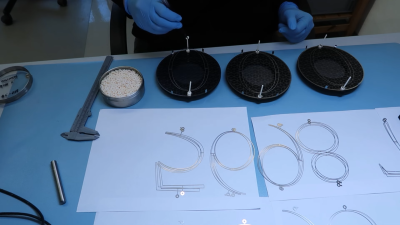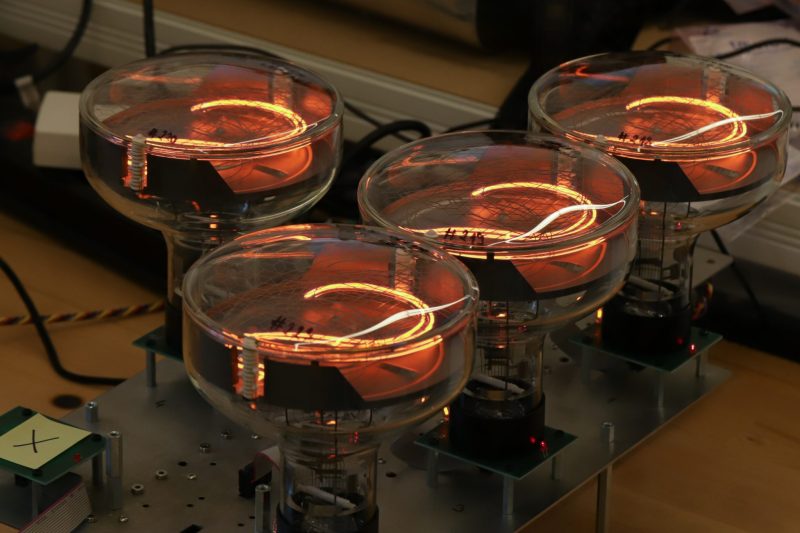Nixie tubes come in many shapes and sizes, but in only one color: the warm orange glow that makes them so desirable. They don’t usually come in large numbers, either: a typical clock has four or six; a frequency counter perhaps eight or nine. But some projects go bigger – a lot bigger in [Dalibor Farný]’s case. He built an art installation featuring more than a hundred jumbo-sized nixie tubes that make an entire wall glow orange.
This project is the brainchild of renowned installation artist [Alfredo Jaar], who was invited to create an exhibition at the Hiroshima Museum of Contemporary Art. Its title, Umashimenkana, means “we shall bring forth new life” and refers to a poem describing the birth of a child amid the suffering and despair following the atomic bombing of Hiroshima. Visitors to the exhibit experience a dark room where they see a wall of orange numbers count down to zero and erupt into a waterfall of falling zeroes.
Nixie tube expert [Dalibor] was the go-to person to implement such an installation – after all, he’s one of very few people making his own tubes. But even he had to invest a lot of time and effort into scaling them up to the required 150 mm diameter, with 135 mm tall characters. We covered his efforts towards what was then known as the H-tube project two years ago, and we’re happy to report that all of the problems that plagued his efforts at the time have since been solved.
 One of the major issues was keeping the front of the tubes intact during manufacture. Often, [Dalibor] and his colleagues would finish sealing up a tube, only for the front to pop out due to stress build-up in the glass. A thorough heating of the entire surface followed by a slow cooling down turned out to be the trick to evening out the stress. All this heat then caused oxidation of the cathodes, necessitating a continuous flow of inert gas into the tube during manufacture. Those cathodes already had to be made stronger than usual to stop them from flexing, and the backplate light enough to keep everything shock resistant. The list goes on.
One of the major issues was keeping the front of the tubes intact during manufacture. Often, [Dalibor] and his colleagues would finish sealing up a tube, only for the front to pop out due to stress build-up in the glass. A thorough heating of the entire surface followed by a slow cooling down turned out to be the trick to evening out the stress. All this heat then caused oxidation of the cathodes, necessitating a continuous flow of inert gas into the tube during manufacture. Those cathodes already had to be made stronger than usual to stop them from flexing, and the backplate light enough to keep everything shock resistant. The list goes on.
After ironing out these quirks, as well as countless others, [Dalibor] was finally able to set up a small-scale production line in a new workshop to get the required 121 tubes, plus spares, ready for shipment to Japan. The team then assembled the project on-site, together with museum staff and the artist himself. The end result looks stunning, as you can see in the excellent video embedded below. We imagine it looks even better in real life – if you want to experience that, you have until October 15th.
You might remember [Dalibor] from his excellent video on nixie clock fault analysis – which we hope won’t be necessary for Umashimenkana. He might be able to make your favorite shape into a nixie tube, too. Thanks for the tip, [Jaac]!
















I’d like to see nixie tubes made with different gases to make different colors like blue or green.
Why not just use other gas mixes for other colors?
“I’d like to see nixie tubes made with different gases”
“why not just use other gas”
?!
Dalibor’s made a few tubes with argon that glow purple. I’d assume there’s some good reason (Longevity issues when using a different gas mixture? Inconsistencies? ) he never offered these for sale.
It’s a fascinating video series, watching the development of these tubes. Well worth the time you’ll need to invest.
Wonderful! I’m as much impressed by the beautiful result of this art installation than by the skills and dedication of the whole team involved in its creation. Would love to participate to such a project ! Congratulations to all the team!
I’m probably going to be the only commentor that doesn’t see the beauty in this. Why not use a wall of P5 panels, monochromatic lasers, or a video projector?
I don’t see what Nixie tubes bring to this installation.
But that would be the easy way out.
You cannot create the effect of symbols made of light floating in the dark with projection methods or flat raster displays without additional moving parts.
Nixie-tube look-alikes are often made with side projected carved acrylic. For better effect, the light can be UV and the carved figures filled with fluorescent paint.
But literally none of those look remotely as good as a nixie tube
EL wire?
I imagine the artist wanted to use a retro type of display to give a period-appropriate feel for the year of the bombing. Nixie tubes aren’t quite old enough, as they were first produced in 1955, but they certainly have a different look and feel than an installation of LEDs, lasers, or even characters displayed on CRTs (which actually WOULD be period-appropriate) would have. Sometimes the medium IS the message, or at least part of it, and I think this is a good example.
I see no period mismatch here, neon glow lamps with symbols were available decades before numeric readout tubes, also glow lamps were used for lighting during wartime blackouts. And there’s the ambivalence in the distinctive neon glow color, it’s both the color of destruction and warmth needed to survive. Bottled man-made fire.
They look a lot better. It’s art, it isn’t about finding the cheapest way to put a bunch of numbers on a wall.
I suspect this is one of those cases where if you truly have to ask that question, then you wouldn’t likely understand the answer.
There is art in engineering, and engineering in art, but the two are not the same. In the art world, creating an “experience” doesn’t always benefit from the use of the latest and greatest tech. If it did, there wouldn’t be people who still make handmade paper, or shoot photos on film, for example.
I’ll admit that I’m not sure I see the connection of this display to Hiroshima… to me it has strong “cold war doomsday” vibes. But then again, everyone can walk away from an art piece with a different impression.
By the way, each of those tubes is an art piece in itself, if you ask me.
I don’t know, the artist wanted the exact (admittedly extremely cool) aesthetic of nixie tubes for some reason and ponied up a fortune to commission Dalibor to make it a reality.
The artwork seems, in my mind, to have more resemblance to WOPR (WarGames, 1983) and the threat of war then a reflection on Hiroshima. But as most suggest, artwork’s interpretation is in the eye and experience of the beholder.
The effort in making the “large” nixie tubes is an entirely separate engineering matter worthy of its own praise.
Great work on Dalibor’s side. As for the art side, I feel like it’s a bit cheap. At the moment Dalibor announced art installation “Project H” I was thinking about Hiroshima because nixies->numbers->countdown. ART! And the digital rain is “borrowed” from The Matrix (1999), which in turn “borrowed” from the Ghost in the Shell (1995) by Mamoru Oshii.
BTW: Is it still legal to say that it was United States of America who dropped the bomb? It has completely disappeared from mainstream media coverage and the bombs just “were dropped”. (Probably by “pro-American group on a rented airplane”).
What are you even talking about?
Is it more appropriate to think that the USA (as we knew it when we were growing up) no longer exists?
It never did exist. Growing up in the cold war, the propaganda was ever prevalent, and now post 9/11 persists to this day. There were never any “good old days”.
“Is it still legal to say that it was United States of America who dropped the bomb? It has completely disappeared from mainstream media coverage and the bombs just “were dropped”.”
What color is they sky in your world / have you taken your meds today.
September 21 2023 – Ursula von der Leyen, the president of European Comission said in her public speech in relation to Hiroshima: “…Russia threatens to use nuclear weapons once again”
WTF?!
As in “threatening” again.
Sadly the United States should not have any high moral ground in Nuclear Disarmament, or any peace process, yet there we are, indeed, picking “winners”.
“A thorough heating of the entire surface followed by a slow cooling down turned out to be the trick to evening out the stress.”
Annealing glass is definitely a thing.
Annealing ovens.
Wife worked at a technical glass blowing place it is an amazing profession.
After fabricating some super complex part and making it look easy they would brush the entire assembly with a large soft flame to remove just enough stress for it not to explode before putting it in annealing oven overnight.
They can also use polarizing filters to see where the stress in the glass but I didn’t get to see that first hand.
As a chemist that frequently found any excuse to go to the glassblowing shop I’ve been in love with it forever. Would make my own soft glass micro pipettes and got good enough to freehand a soft glass spiral eventually.
You can see colored patterns in the door glass of a car or in clear plastic spoons if you want.
for whatever reason, the windshield shows nothing when viewed through a polarized filter, but the rear glass *always* has a colorful repeating pattern
Absolutely fascinating project and beautiful art installation. The disciplines and skills required to pull this off were many.
Excellent video, fantastic end result showing the dedication of the people who made it possible.